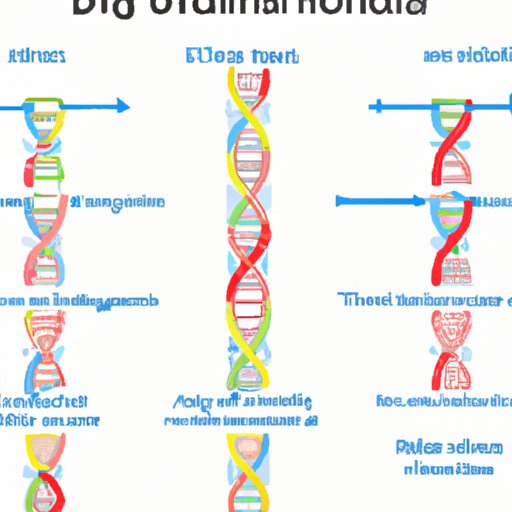Introduction
DNA is a complex molecule that contains all the genetic information necessary to create and maintain life. It’s one of the most important molecules in biology, and understanding how it works can help us better understand ourselves and our place in the world. This article will explore the basics of how DNA works, from its structure and function to its role in heredity and inheritance.
Exploring the Basics of DNA Structure and Function
To understand how DNA works, it’s important to first understand its structure and components. DNA is composed of two strands of nucleotides, which are the building blocks of DNA. Each strand is held together by hydrogen bonds, and the two strands are wound around each other in a double helix formation. The sequence of these nucleotides determines what type of protein will be produced.
DNA carries out its function through the process of transcription, where the DNA sequence is copied into messenger RNA (mRNA). The mRNA then travels to the ribosome, where it is translated into the corresponding amino acid sequence. This amino acid sequence then folds into a specific three-dimensional shape, forming a functional protein.

How Genes are Transferred from Parent to Child
Genetic inheritance is the process by which genes are passed down from parent to child. During meiosis, a special type of cell division, half of the parent’s DNA is randomly selected to be passed on to the offspring. This ensures that each generation is unique and different from the previous one.
The genetic material that is transferred from parent to child is known as the genome. The genome is composed of many different genes, which contain instructions for how the body should develop. These instructions determine a person’s physical traits, such as eye color and hair texture, as well as their susceptibility to certain diseases.
Understanding Mutations and How They Affect DNA
Mutations are changes in the DNA sequence that can result in new traits or an increased risk of disease. Mutations can occur naturally or be induced by environmental factors such as radiation or chemicals. While some mutations can cause disease, others may have no effect at all, or even be beneficial.
Mutations can affect the structure and function of proteins, leading to changes in physical traits or an increased risk of disease. For example, a mutation in the BRCA1 gene can increase a person’s risk of developing breast cancer. Similarly, a mutation in the CFTR gene can lead to cystic fibrosis.

Examining DNA Replication and Repair
DNA replication is the process by which the DNA sequence is copied so that it can be passed on to the next generation. This occurs during cell division, when the cell splits into two identical copies. DNA repair is the process by which damaged DNA is repaired to ensure that the sequence remains intact.
DNA repair mechanisms are essential for maintaining genetic stability and ensuring the accuracy of genetic information. Without them, cells would be unable to replicate accurately, leading to genetic errors and disease.
Investigating the Role of DNA in Heredity and Inheritance
DNA plays a crucial role in heredity and inheritance. Each person inherits a unique combination of genetic information from their parents, which determines their physical characteristics and susceptibility to certain diseases. This genetic information is passed down from generation to generation, allowing us to trace our ancestry and learn more about our family history.
DNA also plays a role in determining which traits are inherited. Genes are composed of alleles, which are variations of the same gene. Some alleles are dominant, while others are recessive. If a person inherits two dominant alleles, they will express that trait. However, if they inherit one dominant and one recessive allele, they may not express the trait.

Exploring the Impact of Environment on DNA
The environment can have a significant impact on DNA. Environmental exposures such as radiation, chemicals, and tobacco smoke can damage DNA, leading to mutations and an increased risk of disease. Long-term exposure to pollutants can also lead to epigenetic changes, which are alterations in gene expression without changing the underlying DNA sequence.
It’s important to be aware of the potential long-term effects of environmental exposure. Understanding how the environment affects DNA can help us make informed decisions about our health and the health of future generations.
Conclusion
DNA is an incredibly complex molecule that plays a vital role in the functioning of the human body. This article has explored the basics of how DNA works, from its structure and function to its role in heredity and inheritance. We’ve also examined how environmental factors can affect DNA and how mutations can occur. Further research is needed to better understand the implications of these findings and how they can be applied to improve human health.
(Note: Is this article not meeting your expectations? Do you have knowledge or insights to share? Unlock new opportunities and expand your reach by joining our authors team. Click Registration to join us and share your expertise with our readers.)
